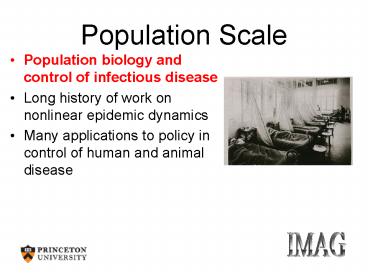Population Scale PowerPoint PPT Presentation
1 / 8
Title: Population Scale
1
Population Scale
- Population biology and control of infectious
disease - Long history of work on nonlinear epidemic
dynamics - Many applications to policy in control of human
and animal disease
IMAG
2
Population Scale
- a) How modeling has impacted epidemiology
- basic research Modeling (along with
statistical analyses of rich epidemiological data
sets) captures the essence of the epidemic
clockwork in many settings.
IMAG
3
Population Scale
- Key role of individual and population
heterogeneities - Eg Measles in the UK and the impact of baby booms
and schooling (Grenfell et al Nature 2001)
IMAG
4
Population Scale
- Epidemics, models and policy (examples)
- Control of measles and rubella
- HIV epidemic
- BSE/CJD
- The UK Foot and Mouth epidemic of 2001
- Antibiotic resistance
- Assessing threats and possible control of
smallpox - Pandemic influenza, both pre- the current
epidemic (mainly via the NIH/NIGMS MIDAS Program)
and in the current pH1N1 pandemic. - Key ingredients The right data and biology
understanding uncertainty realistic
expectations several voices
IMAG
5
Population Scale
- b) To what extent has the broader research
communities accepted modeling as a critical tool
for driving research or policy? - Works especially if models seek to engage with
biology (grant schemes can help this, eg MIDAS,
NSF/NIH Fogarty EID Program) - However, many inroads still to make still a
basic skepticism in some quarters about utility
of modeling
IMAG
6
Population Scale
- c) How far can we go? Huge potential, but
- Theorists not always integrated into mainstream
research (as physicists or engineers would be). - ..this can cause obvious problems in
communicating results, as well as limiting
realism of models and opportunities for model
validation if key data sets are neglected. - More quantitative training would obviously help,
especially in developing a feel for whats under
the hood of models. - Modeling disciplines in biomedicine still too
siloed, especially across integrative scales...
IMAG
7
Population Scale
- Major research challenges eg integrating
epidemiological and evolutionary dynamics of
pathogens - Significant recent progress, eg immune escape in
seasonal influenza. But problem is essentially a
cross-scale one (from viral and immune molecules,
through transmission to epidemic dynamics and
global viral phylogenies
IMAG
8
Population Scale
- Major issue gaps in cross-scale data
- Eg relating genetic change of influenza to
transmission rate via immune escape (Park et
al Science 2009)
IMAG

